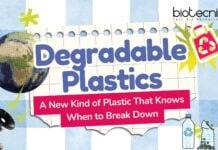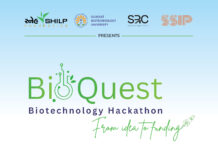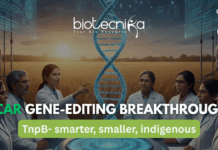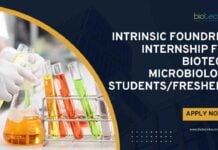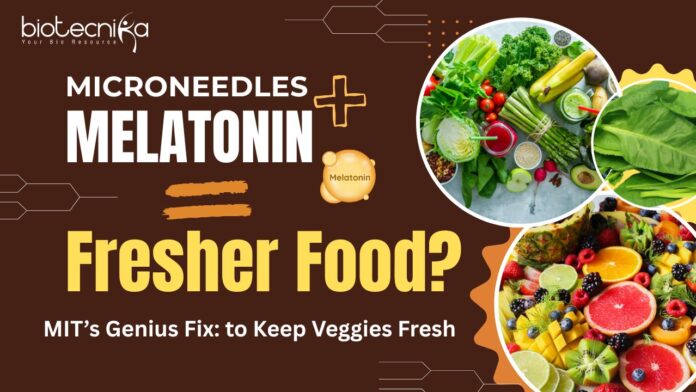MIT-SMART Fresh Vegetables Technology – Microneedles + Melatonin
Imagine your leafy veggies being fresh and crisp for longer days, even without freezing them at low temperatures. It might sound like fiction, but increasing the shelf life of vegetables has always been a top mission for scientists.
Researchers at the Massachusetts Institute of Technology (MIT) and the Singapore-MIT Alliance for Research and Technology (SMART) have developed a pioneering method to enhance the freshness of harvested vegetables. They successfully increased the shelf life of vegetables, which remained fresh for four additional days at room temperature and ten days when refrigerated.
This innovative method utilizes biodegradable silk microneedles to administer melatonin directly to plants, which has been demonstrated to prolong the shelf life of produce by as much as four days at room temperature and ten days when refrigerated.
Silk Fibroin Microneedles:
- Silk Fibrin is a natural polymer derived from silkworms. Because of its biocompatibility, Mechanical robustness, and Controlled biodegradability characteristics, it is prominently used for microneedle-based drug delivery systems.
- Silk fibroin microneedles leverage the natural properties of silk protein for transdermal drug delivery, vaccination, and cosmetic applications.
- It is less painful when compared to other conventional methods of injection.
- It is precisely engineered to penetrate the depths of the skin.
Structure of the silk fibroin microneedle:
- Diameter: Ranges from 50 nm to 40 micrometers
- Body length: Ranges from 15 to 1500 micrometers
They are designed to deliver vaccines, antibiotics, hormones, peptides, and antibodies more precisely to the target sites. At room temperature, at least 30% of a biological agent’s bioactivity will remain in the body for about 24 hours, which is maintained with the help of this novel delivery system. Researchers have also discovered they can use the same silk protein microneedle to diagnose diabetes.
Melatonin:
It is a hormone primarily secreted by the pineal gland in response to darkness, and widely known for regulating the sleep-wake cycle. Recent studies have revealed that it has anti-aging or anti-senescence properties that help extend the shelf life of plants. Melatonin governs the physiological pathways in plants to increase their shelf life. It combines and coordinates with plant hormones to regulate senescence. Several studies have revealed the effectiveness of melatonin, which helps extend the shelf life of food products like Chinese flowering cabbage, broccoli, kiwifruit, and okra.
Mechanism of action:
- Melatonin upregulates the gene expression of chlorophyll a/b-binding protein (CAB) to lengthen the degradation of chlorophyll.
- Simultaneously, melatonin increases the activity of protective enzymes like peroxidase, superoxide dismutase, and catalase to enhance the antioxidant capacity of the chlorophyll.
- The increased activity of these enzymes helps reduce harmful substances like ROS (reactive oxygen species) and MDA (malondialdehyde), which are high during plants’ senescence.
Advantages of supplementing melatonin to plants:
- It increases the levels of growth-promoting hormones like gibberellic acid and GABA.
- It decreases the levels of hormones that promote senescence, like abscisic acid.
- It strengthens plant physical structures by increasing the thickness of the leaf cuticle and wax accumulation and improving the palisade/spongy tissue ratio in senescing leaves, protecting against deterioration.
Precise solution for the global food challenge
Did you know that almost one-third of the yield produced globally is lost due to wastage or spoilage every year? This not only affects the global economy but also wastes farmers’ cultivation efforts. It even contributes to unnecessary carbon emissions, waste of raw materials, and land misuse.
Microneedle technology will serve as a ray of hope for the global battle against food waste. Farmers and market agents use synthetic chemicals or energy-intensive refrigeration to keep the harvest fresh. Microneedle technology is a clean, efficient, and ecologically sound alternative.
The current study focused on pak choy, but the technology’s adaptability could soon be applied to various crops, from spinach and lettuce to strawberries and tomatoes.
Expanding the idea beyond freshness
The possibilities and expectations dont just end at increasing shelf life.
Researchers are already on the edge of ther seats to envision and expand different applications of these microneedles in the food and agriculture industry. One of the significant ideas was to use microneedles to deliver beneficial molecules to plants, a pretty targeted and precise idea. This technology can be further utilized to fortify fruits with nutrients post-harvest or to protect vulnerable yields by injecting natural antifungal or antibacterial agents.
“We’re going to continue to analyze how we can increase the impact this can have on the value and quality of crops,” says Marelli. Could this let us modulate the nutritional values of the crop, modify its shape, its texture, etc.? Researchers are also continuing to look into scaling up the technology so that it can be used in the field.
The aroma and flavours of fresh leafy vegetables or fruits can be enhanced naturally; this technology has opened doors to advanced perspectives. This platform could revolutionize plant care at the cellular level, not just after the post-harvest scenario, even in the field.
Bottom line: This fantastic breakthrough in microneedle technology marks a revolutionary moment in the history of post-harvest agriculture. Nothing goes to waste in nature; every minute of creation has its importance. By harnessing the power of melatonin and delivering it through engineered silk, MIT and SMART researchers have reached a new milestone while being sustainable and limiting waste residue.
Fresh food is a daily necessity and a global challenge, while this innovation is clever and sustainable, it is essential.

